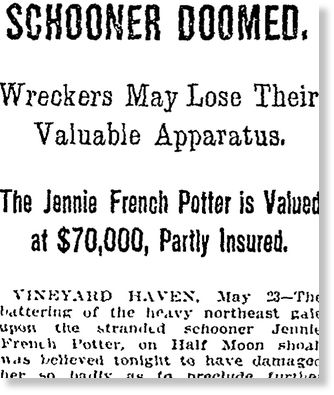The five-masted Jennie French Potter, 260 feet long and bound for Boston with a cargo of Appalachian coal, sailed into Nantucket Sound in May 1909 on what was the interstate highway for East Coast maritime commerce.
A perilous combination of weak winds and strong tides pushed the Maine-built behemoth onto shallow Half Moon Shoal, where the vessel was grounded, stripped by salvagers of its 150-foot masts, and abandoned in 25 feet of water about 10 miles south of Yarmouth.
The Jennie French Potter would remain there for more than a century, until two Cape Cod divers found the old workhorse in December on a blanket of white sand, its iron wheel upright, and its oaken ribs scattered among a school of tropical triggerfish.
They returned to the ship last week, when 25-foot visibility and 75-degree water gave them dream conditions to study the aftermath of a nightmare voyage for Captain Joseph Potter, his two daughters, and his crew, all of whom survived.
"When I got underwater and saw the length and the size and the girth of the ship, all I could do was smile, because we had captured another shipwreck from the pages of history,'' said Don Ferris of Sandwich, one of the divers.
Vic Mastone, state director of underwater archeology, said the freighter, launched in 1899, is a rare, important discovery. Fewer than 60 five-masted coal schooners were built on the East Coast, Mastone said, so the wreck could provide valuable insight into construction techniques used at the Camden, Maine, shipyard.
That sense of history keeps Ferris in the water. "It's the feeling,'' Ferris said, "that a diver gets when you see something that hasn't been seen for so long and the possibility that when you brush away the sand, you'll touch something that hasn't been touched for 100 years.''

"That was the trucking highway of the Northeast,'' said Chuck Carey, 60, of West Dennis, who had towed sonar over Half Moon Shoal for a few years in an unsuccessful hunt for the ship.
"It was very well documented that the ship went down in this general location, but everything moves,'' said Carey, a commercial real state broker. "The shoals move. The buoys aren't in the same place as 100 years ago. It really bothered me that nobody could seem to put their finger on it.''
In November, after a good hit in the area, a diver reported seeing lumber but little else in the murky water, Ferris said. The next month, Ferris and Carey returned and confirmed in better conditions that those timbers belonged to the Jennie French Potter.
The keel, a massive stack of 17-by-17-inch timbers laid on top of each other, protruded from the bottom. Hundreds of feet of metal cable used to support the rigging snaked over the shoal. And wooden planking, its iron fittings rusted and broken, lay jumbled on the sand.
Before the disaster, Potter had anchored for the night in the center of the sound as he waited for favorable winds to carry him east toward Monomoy Point, then north toward Provincetown, and finally west to Boston.
The captain got under way at dawn, "but the tide was stronger than the wind, and the schooner was carried to the north side of the channel, where she struck the tail of the shoal,'' according to a Boston Globe report on May 19, 1909.
"He just misnavigated and caused himself his own grief,'' said Ferris, 52, who has written books on Cape Cod shipwrecks. "It was just a poor job of captaining.''
One man's misfortune, however, was another's good luck.
"I've dived hundreds of shipwrecks over 30 years, and this is only the second ship's wheel I've ever spotted,'' said Ferris, a web designer. "To have it in such shallow water, in such a heavy fishing area, it almost looked like it was still sailing the ship.''
Mastone, who heads the Massachusetts Board of Underwater Archeological Resources, said the Jennie French Potter will be accessible to the public because it lies in federal waters and was a privately owned vessel. But with such access comes concern.
"Since it's in federal waters, there's no real protection of it from any kind of vandalism,'' Mastone said. Ferris's plan is to "leave it in place where it is, as a keepsake for other divers,'' he said. "Hopefully, other divers will leave it alone.''
Mastone applauded that intention. "I hope that people are as good to the site as he's been,'' Mastone said. "I think it would be a shame if someone took that iron wheel out. It's not the kind of thing that will look good on your mantel.''




Reader Comments
to our Newsletter